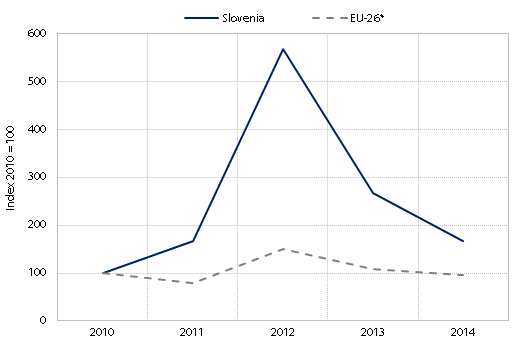ENVIRONMENTAL WELL-BEING - Climate
The indicator Severe weather warnings shows the number of days when the national meteorological service in Slovenia issued a severe weather warning, when there is a high probability of large material damage and accidents, and danger to human life in a wider area (red alert). The increase in the appearance of extreme weather events – such as heavy rain with possible flooding, severe thunderstorms, damage-causing wind, heat waves, fires in the natural environment, thick fog, heavy snowing and extreme cold, avalanches and high tide – increases the threat for humans and the danger of material damage. The increase in the frequency of extreme weather events in linked to climate change. Growth of the indicator has a negative impact on well-being.
Figure: Severe weather warnings, Slovenia and the EU, 2010–2014 (number of days in the country per year; index 2010=100)

Source of data: EUMETNET, www.meteoalarm.eu.
Note: EU-26*: Bulgaria and Lithuania are missing.
In the 2010–2014 period, the Slovenian Environment Agency issued the highest warning about the danger of weather conditions (red alert) for three to 17 days per year. The largest number of red alert days in Slovenia was recorded in 2012, when alerts were issued in January due to strong wind, in August due to high temperatures, drought and high danger of fire, and in November due to floods. In 2013, alerts was issued for a strong heat wave in early August and in 2014 for a snow storm in the winter and for heavy rain in the fall. In the EU, too, most severe weather warning days were recorded in 2012.
Results of the supplementary indicator show:
Greenhouse gas emissions per capita in Slovenia have been gradually declining since 2008. In 2013 they were 3.5% lower than a year earlier but still above the EU average. The main reason for lower emissions is lower fuel consumption in electricity and heat generation due to modernisation of combustion installations and a warmer winter, which lowered emissions in commercial sectors and in households. In Slovenia, transport emissions are rising the fastest. Since the onset of the economic crisis, greenhouse gas emissions declined both in Slovenia and in the EU, but the decline in Slovenia was mostly the result of the decline in economic activity. Many measures were adopted to improve energy efficiency in the energy sector and transport.
